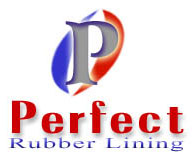
|
|
|
In general, a surface which requires protective coating from wear, corrosion and rust, a coat of rubber lining is applied. The lining of rubber is mostly applied to inner surfaces of the container. The surface to be rubber lined has to be cleaned by sandblasting to white metal. When the old lining to be replaced, surface decontamination may be required prior to sandblasting. Then the surface will be coated with adhasive with the help of a brush or roller. The adhesive. coating consists generally of two to three coats of different adhesives. Then rubber is applied by cutting the rubber sheet to fit to the shape of the surface to be lined and adhering it to the surface. Care is taken to remove any air trapped between surface and the rubber sheet. A special care to be taken for this. For pipe linings, a specialised methods are followed. Then the rubber along with the surface to be cured or in other words vulcanised in autoclave or under cover of steam or hot air. The final inspection consists of spark testing the lined surface by a high voltage which detects any pin holes in the lining and if it is found they has to be repaired and retested before putting the surface in required service.
Applications Mechanical Conveyor rollers and pulleys, Rollers for Printing, Food, Dyeing, Textile, Pads for anti-vibration, Computer printer rollers, and etc Chemical Storage tanks, Water treatment plants, Process tanks, piping, Agitators, Centrifuges, Blowers, Gaskets, and etc Fertilizer Storage tanks, Water treatment plants, Vaccum crystalizers, Pipings Storage tanks, and etc Electromechanical Mercury cells and accessories, Pipings and etc Mining Reaction vessels and tanks, Chutes, Settling tanks & pipings and all types of pumps Environment Scrubbers, Reaction tanks & vessels, Water treatment, Fans, Pumps and Pipings General Different types of Gaskets, Valve packings, Different sizes & types of Bushes, Vibration dampers, Foundation purposes, Oil seals, Automobile washers, Various types of Fenders, Anti corrosive, Anti errosive, Aircraft and ship parts and etc Applied
Company & industrial Rubber Lining -
|
|
|
